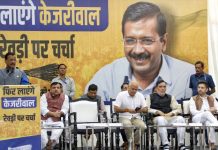A blogger named Sindhu Keshavamurthy said that fashion magazine Vogue India is not yet in vogue. That is because despite its potential, Indian fashion accounts for a meagre 0.2 per cent in the world market, a situation belied by its high media visibility. That is why my conversation with young New York-based fashion designer Rishabh Manocha was very interesting and worth writing about.
 Rishabh informed me that he was a bright student right through, which made me question him aloud about how, in the STEM driven obsession of Indian parents, did he get to pursue fashion as a career? His parents, he told me, did not need much convincing, an answer that I responded to with a questioning look. “To be entirely honest, there were moments of skepticism about the nature of my area of study, but certainly not about my place in it. It came rather intuitively to me, and my parents recognized that early on,” he hastened to explain.
Rishabh informed me that he was a bright student right through, which made me question him aloud about how, in the STEM driven obsession of Indian parents, did he get to pursue fashion as a career? His parents, he told me, did not need much convincing, an answer that I responded to with a questioning look. “To be entirely honest, there were moments of skepticism about the nature of my area of study, but certainly not about my place in it. It came rather intuitively to me, and my parents recognized that early on,” he hastened to explain.
His initial introduction to fashion came from his parents’ friends, “especially in the drape of their sarees. The most vivid memories are of those who wore their saree most fastidiously, most gracefully. The understated romance of what Joanne Entwistle calls fashion, a situated bodily practice, really manifests itself at multiple levels in the making, wearing and flaunting of a saree,” he explained. His statement made me think of how quotidian the saree is in India’s life and how we often dismiss it as non-glamorous. And here was this young man looking at its drapes as haute couture! I had new-found respect for the many six yarders hanging in my cupboard.
According to Rishabh, the perception of fashion has certainly changed immensely in India. What till about two decades ago used to be mere talk at luncheons, has morphed into serious transnational economic opportunities. Today, we see successful design collaborations between Indians and international labels. “These collaborations are not just beauty driven, they talk of ethics, of labour laws, of feminism, of a whole pandora of things that are far from frivolous,” he said.
Frivolous is a word that is often thrown at the fashion industry, especially in a country like India where poverty is endemic and fashion often perceived as non-essential and an indulgence, I ask him, and he has an answer ready for me. “One thing often ignored and yet so apparent is fashion’s ability to reflect the condition of our times. Both poverty and prosperity are reflected in clothing inadvertently,” he argues and then challenges the charge of elitism. “Today, we see many high fashion brands get their inspiration from sub-cultures that were once under the radar, almost pejorative to acknowledge. Today, they feed the increasingly democratic landscape of society,” he says, going on to explain the power of the Kantha embroidery of Bengal as an art of the poor that is now finding pride of place in high fashion.
The designer’s ideas on the following:
• Up cycling: Very important. But, let’s not sell more in the name of upcycling products. Upcycling is meant to reduce consumption, not introduce a new means of consumption.
• Minimalist v/s Maximalist debate:
Context is rather important. I do not identify with any hard bound schools of thought. As long as the narrative makes sense, everything has a place.
• Roots in tradition: It is crucial to have a sense of belonging even though one may not identify with it. Tradition, as one of my acquaintances once said to me, I use in a whimsical manner, creatively not to bind things together, but rather to liberate them. I think that was the best compliment I received.
What defines his work, gets and eager answer from him. “The opposition of extremes plays a rather important role in my life and work. I try to keep my silhouette lines very clean, very ‘western’ for lack of a better word. And I like to define and complement those lines with ‘eastern’ elements of surface treatment. It is, like life, a constant work in progress towards harmony.” He thinks a while and then refers to normative aspects of his work. “The ethics of production is one of the most pressing issues of our times, and a deep concern for me. Look at the craftsmen in Kashmir, or the embroidery masters in Madras, poorly compensated but greatly revered. That is one of fashion’s greatest paradoxes. The value is in the product, not in the people who make it. But, I am confident that millennials such as me with their conscious consumerism habits have an answer to that”.
My next question to Rishabh was about the wearability of haute couture, especially because of its unreal sizes. Rishabh is apparently studying bespoke pattern-cutting from master tailor Rory Duffy of Henry Poole & Co. As part of his studies with the Saville Row Academy, his tutorials include learning to measure the male body, draft patterns for jackets, trousers and waistcoats alongside making adjustments for heavier figures. “Since I specialize in the making of bespoke garments, let me clarify that ideally right from fabric selection, pattern-cutting to tailoring, everything is done for one size, at once. There are no two sizes up, no two sizes down. It is just perfect regardless of the nature of your body. That is reflective of the virtuosity of a tailor, and the skill-set of a designer. My designs are rather wearable for any body type as they are created as a portrait of my clients, almost like a second skin”.
Referring to him talk about his tutorials at the Saville Row Academy led me to question him about his days as a student at the Parsons School of Design in New York, and at the Central Saint Martins College of Art and Design in London. The question evidently evoked great memories. “Ah! Fun days, they were. The initial euphoria of being in art school in tandem with a new-found creative voice were very empowering aspects of my life. I would always question my teachers on their teaching, on course planning, on the direction in which the industry was headed. And, more often than not they found what I said quite insightful and honest. I think my days as a student inspire me to become a tutor. And I did design and teach a course in pattern-cutting for menswear for The University of Fashion in the autumn after graduation. And, I do plan to return to teach very soon.” So here we have a hands-on guy who wants to prepare the next generation. Truly, Rishabh is a mix of old ideals and values and new sensibilities.
 Once you get to know that, it doesn’t come as a surprise that he is vegetarian, a yoga practitioner and fluent in Sanskrit. I cant think of any other designer who is fluent in Sanskrit. “My study of Sanskrit does not make me any more or less Indian, it just enables me to broaden my understanding of linguistics. As an advocate of yoga, animal rights, and vegetarianism in fashion, I feel it is important to substantiate my ideology, both as a designer and an individual. Sanskrit does that for me from all ethos, pathos and logos standpoints. Its rich vocabulary, immersive literature, and time-honoured fables are deeply piercing. I count on Sanskrit as an incontrovertible strength in my life as a designer,” he claims.
Once you get to know that, it doesn’t come as a surprise that he is vegetarian, a yoga practitioner and fluent in Sanskrit. I cant think of any other designer who is fluent in Sanskrit. “My study of Sanskrit does not make me any more or less Indian, it just enables me to broaden my understanding of linguistics. As an advocate of yoga, animal rights, and vegetarianism in fashion, I feel it is important to substantiate my ideology, both as a designer and an individual. Sanskrit does that for me from all ethos, pathos and logos standpoints. Its rich vocabulary, immersive literature, and time-honoured fables are deeply piercing. I count on Sanskrit as an incontrovertible strength in my life as a designer,” he claims.
Going through his resume, I find that Rishabh has worked on tailoring and fitting for celebrities. I ask if he can talk about some of that experience, wondering that while his creations that I had seen virtually fitted that demographic well, but were those numbers large enough? “One of my most exciting work projects was to alter garments for the likes of Nicki Minaj and J. Lopez. It was indeed very unnerving sewing those garments for a multi-million dollar shoot. I saw the importance of perfection. The need to strive to be the best version I could be in the moment, as people more often than not putting their best foot forward regardless of their stature in the industry,” he said. It seems that Rishabh takes back from every experience the best it has to offer without losing site of the reality of the situation, for he added, “As far as demographic goes, my designs are quite wide-ranging. They attract everyone from drag queens, socialites, auctioneers to dandies”.
Dandies! ‘Gandhi Dandy’ was a term I had seen in his papers. It intrigued me. “Yes. MK Gandhi was indeed a dandy although nobody acknowledges him as thus. He used the consistency, the sobriety, and the power of his clothing, or lack of it as some would argue, to make a very powerful statement. As I said, fashion more often than not has a penetrative ability to reflect the nature of our times. And Gandhi, much like many dandies, used his clothing as a means to curate his socio-political stance,” he said convincingly. Well, that is a different take on Gandhi if ever there was one. Wonder what the Mahatma would say to it!
letters@tehelka.com












